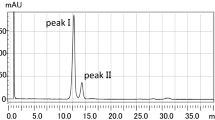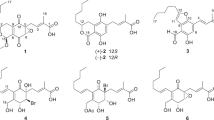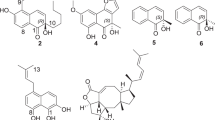Abstract
PHTHIOCEROL, a characteristic constituent of the waxes of human and bovine strains of tubercle bacilli1–3, was found by Stodola and Anderson1 in 1936 to be a methoxy-glycol with the formula C34H67(OH)2OCH3 or C35H69(OH)2OCH3. About ten years ago it was shown that phthiocerol has a long-chain structure with a methyl branch in position 4 4–6. More recently the presence of a β-glycol grouping was demonstrated7,8, and several structural formulæ have been suggested on the basis of degradation experiments (for a review see ref. 9). Definite evidence that the methoxyl group is attached to carbon atom 3 adjacent to the methyl group was first obtained by a mass spectrometric study of phthiocerol10,11, and this was afterwards confirmed by chemical studies12–14. The mass-spectrometric results also indicated the presence of a hydroxyl group in position 22 from the straight-chain end of the molecule. The mass spectrum of a purified sample of phthiocerane, the hydrocarbon obtained by reduction of phthiocerol15, showed this compound to consist mainly of 4-methyltetratriacontane11. Structure (I) for phthiocerol was suggested on the basis of the mass spectrometric study11.
This is a preview of subscription content, access via your institution
Access options
Subscribe to this journal
Receive 51 print issues and online access
$199.00 per year
only $3.90 per issue
Buy this article
- Purchase on Springer Link
- Instant access to full article PDF
Prices may be subject to local taxes which are calculated during checkout
Similar content being viewed by others
References
Stodola, F. H., and Anderson, R. J., J. Biol. Chem., 114, 467 (1936).
Reeves, R. E., and Anderson, R. J., J. Biol. Chem., 119, 535 (1937).
Cason, J., and Anderson, R. J., J. Biol. Chem., 119, 549 (1937); 126, 527 (1938)
Ställberg-Stenhagen, S., Stenhagen, E., Sheppard, N., Sutherland, G. B. B. M., and Walsh, A., Nature, 160, 580 (1947).
Ställberg-Stenhagen, S., and stenhagen, E., J. Biol. Chem., 173, 383 (1948).
Ställberg-Stenhagen, S., and Stenhagen, E., J. Biol. Chem., 183, 223 (1950)
Demarteau-Ginsburg, H., and Lederer, E., C.R. Acad. Sci., Paris, 240, 815 (1955).
Hall, J. A., Lewis, J. W., and Polgar, N., J. Chem. Soc., 3971 (1955).
Demarteau-Ginsburg, H., thesis, Paris (1958).
Ryhage, R., Stenhagen, E., and von Sydow, E., Acta Chem. Scand., 10, 158 (1956).
Ryhage, R., Stenhagen, E., and von Sydow, E., Acta Chem. Scand., 11, 180 (1957).
Demarteau-Ginsburg, H., C.R. Acad. Sci., Paris, 243, 2169 (1956).
Lewis, J. W., and Polgar, N., J. Chem. Soc., 102 (1958).
Drayson, P. K., Lewis, J. W., and Polgar, N., J. Chem. Soc., 430 (1958).
Ginger, L. G., and Anderson, R. J., J. Biol. Chem., 157, 213 (1945)
Hall, J. A., and Polgar, N., Chem. and Indust., 1293 (1954).
Ryhage, R., Stenhagen, E., and von Sydow, E. (to be publihed).
Demarteau-Ginsburg, H., Ginsburg, A., and Lederer, E., Biochim. Biophys. Acta, 12, 587 (1953).
Ahlquist, L., Ryhage, R., Stenhagen, E., and von Sydow, E., Arkiv za Kemi. (to be published).
Author information
Authors and Affiliations
Rights and permissions
About this article
Cite this article
DEMARTEAU-GINSBURG, H., LEDERER, E., RYHAGE, R. et al. Structure of Phthiocerol. Nature 183, 1117–1119 (1959). https://doi.org/10.1038/1831117a0
Issue Date:
DOI: https://doi.org/10.1038/1831117a0
This article is cited by
-
Mass spectroscopy: A tool now available to the fatty acid chemist
Journal of the American Oil Chemists' Society (1966)
-
Die Anwendung der Massenspektroskopie zur Strukturermittlung von Naturstoffen, mit besonderer Berücksichtigung der Lebensmittelanalytik
Zeitschrift für Lebensmittel-Untersuchung und -Forschung (1963)
-
Massenspektrometrie als Hilfsmittel bei der Strukturbestimmung organischer Verbindungen, besonders bei Lipiden und Peptiden
Fresenius' Zeitschrift für analytische Chemie (1961)
Comments
By submitting a comment you agree to abide by our Terms and Community Guidelines. If you find something abusive or that does not comply with our terms or guidelines please flag it as inappropriate.



